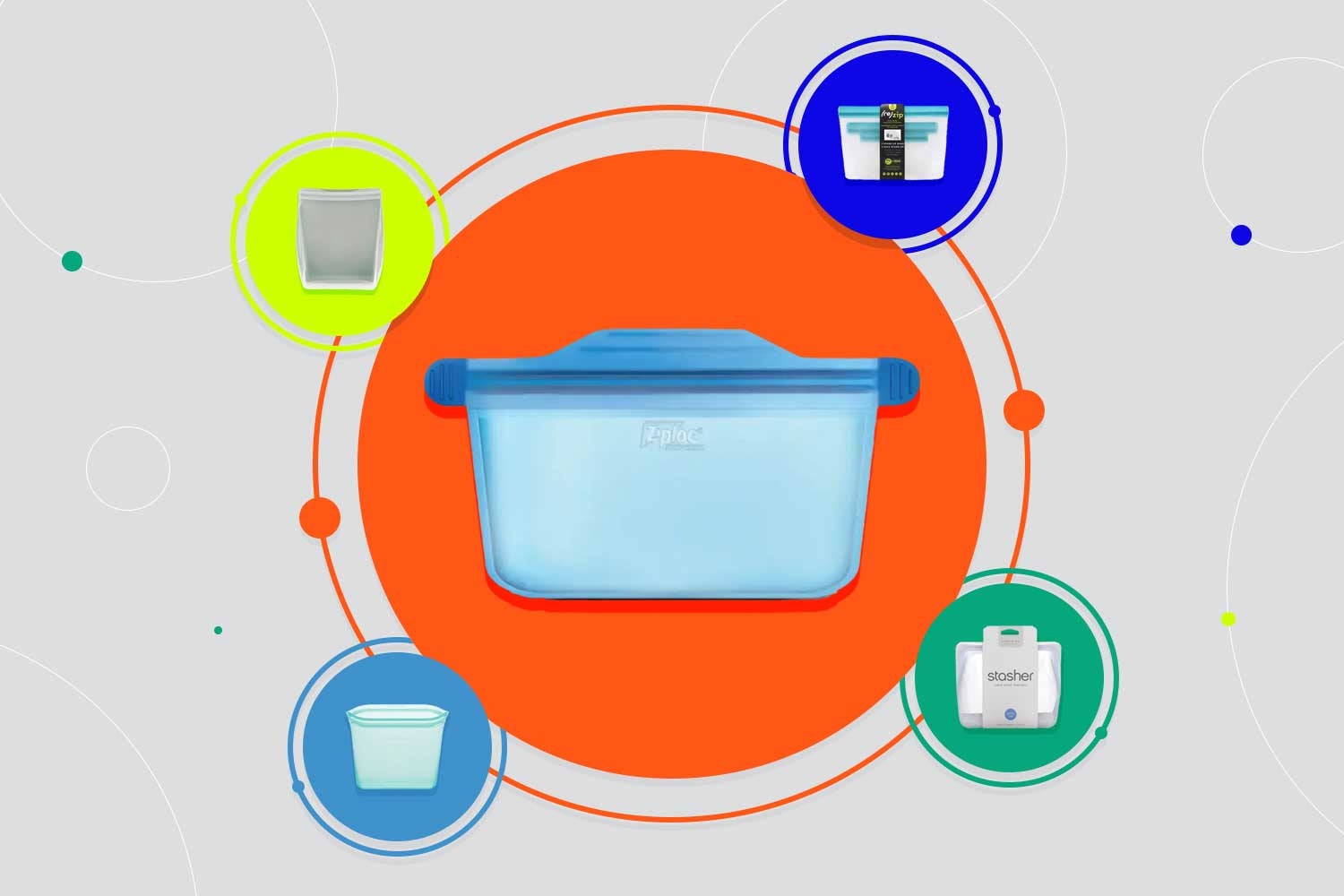Hey team, and welcome back to one5c! When we designed our product reviews program, we knew this moment would come: After we put five of the top reusable food-storage bags to the test, clocked in every brand’s Earth-friendly merits (and demerits), and ran our algorithm to reveal the winner, the overall champion and the most sustainable bag were…different products.
This isn’t a glitch in the system. This means it’s working. Our writers and editors don’t pick the winners of our tests. Our math does. We designed our algorithm to weigh each item’s performance and environmental impact as objectively as possible. How well a product does its job makes up 50% of its score, and that’s also a factor in how good it is for the planet, because if we recommend something perfectly sustainable that nobody likes using, everyone will probably chuck it. And then we made trash. Similarly, we can’t recommend a high-performer that’s awful for the planet. There’s a push-pull thing happening here, and it results in a recommendation with the best balance of performance and sustainability.
Y’all have heard me talk about balance before, about being perfectly imperfect. This is that concept in practice. Suffice it to say, we were equal parts surprised and unsurprised at this week’s winner. Let’s get to it. —Corinne
SPONSOR

THE BEST FOOD-STORAGE BAGS FOR PEOPLE WHO CARE ABOUT SUSTAINABILITY
By Matt Berical & Lizzie Horvitz

The sealable, single-use plastic bag is as much a staple of the home kitchen as a frying pan or set of tongs. They function as snack transporters, marinating vessels, and leftover storers. So ingrained are these bags in American homes that a single household uses upwards of 500 per year. That’s a lot of bags—and a lot of plastic waste added to the already horrific amount that clogs and pollutes our land, waterways, and even our bodies.
As we all work to trim our ration of single-use plastic, reusable food-storage bags are a no-brainer. In a lot of ways, they’re actually on another level: Sure, they’ve got familiar press-and-seal closures, can tuck easily in any fridge, freezer, pantry, or lunch box, and have firm-yet-flexible forms that make it simple to, say, massage in a marinade. But many of them are also oven- and microwave-safe and have wide, flat bottoms so they can stand sturdily upright for filling or fridge placement.
Reusable food-storage bags are a simple, practical swap for their flimsy plastic brethren—if they work. You need to use a bag a lot to have a shot at reaping its enviro-benefits. And there are plenty of options available. But which is worthy of a spot in your kitchen drawer? We put five popular models through a series of five seal-stressing tests and dug into their sustainability stories to find the one that offers an ideal balance of performance and Earth-friendliness.
What we tested
Similar to the baggies in your drawer, reusable food-storage bags come in a range of sizes, from snack packers to big’uns for the freezer. Most companies offer two form factors: floppy models and more-structured vessels with wide bottoms that stand upright. We evaluated each, as they’re useful for different purposes: The floppier ones are best for dry snacks and things like fruit slices, while the container-style ones are more suited for leftovers and soupier foodstuffs.
We tried out the Stasher Bags Stand-Up Trio as well as its Reusable Sandwich Bag; the (Re)Zip 3-Piece Stand-Up Kit and Half Gallon (Deli) Bag; the W&P Reusable Bag Starter Set; the Zip Top Reusable Bag 2-Set and snack bag; and the Ziploc Endurables Large Pouch, Medium Pouch, and Medium Container. The all-in prices vary depending on how you mix and match, but expect to drop in the $50 range for an initial kit of 3 to 5 bags. All the vessels have press-to-seal, zipper-style closures, come in a range of sizes and colors, and are all pretty easy to find, shopping-wise.
A quick PSA before we go further: None of these bags are blissfully plastic-free. The majority are silicone, which is a polymer made by reacting silica with hydrocarbons. Think of it kinda like a hybrid that’s mostly synthetic rubber and some plastic. The material’s super durable, so it’s less likely to release microplastics at high temps; that doesn’t stop it, however, from shedding bits and pieces if it meets the pointy end of a knife or tooth or blender blade. Some bags, like (Re)Zip, are made from PEVA—that’s ethylene-vinyl acetate, which is straight-up plastic.
THE ROUNDUP
In the news this week
The Environmental Working Group (EWG) has sued Tyson Foods over its “climate-smart” beef. The suit asserts that the meat producer is using the stamp as greenwashing for “well-intentioned” buyers. The firm’s net-zero claims center on buying carbon offsets to cancel out the emissions of its livestock business, but, as EWG points out, the volume of offsets needed to hit that mark are “both unfathomable and unavailable.”
The city of London has uncovered an unexpected benefit of its congestion pricing program, which charges vehicles a premium for entering the city’s central zone: fewer kids are getting driven to school. The data, published in the International Journal of Behavioral Nutrition and Physical Activity, found that 2 of 5 tykes were walking, biking, scootering, or taking transit instead.
Fossil fuel companies are spending some $5.6 billion on sports sponsorships, according to a new report. This “sportswashing,” reports DeSmog, is a means to garner positive public sentiment—so that they can continue their world-warming pursuits with a social license to do so. “Oil companies…are using Big Tobacco’s old playbook and trying to pass themselves off as patrons of sport,” Andrew Simms, co-director of the New Weather Institute, told the outlet.
Some 40% of young voters in battleground states say they’ll only support political candidates who prioritize climate action, according to recent polling data from the Environmental Voter Project, a nonpartisan organization focused on getting eco-minded voters to the ballot box. The poll—which took place in Arizona, Georgia, Nevada, North Carolina, and Pennsylvania—found that preference crosses party lines.
Solar panels are now cheap and available enough that they’re proliferating rapidly in the developing world, writes Bill McKibben in this week’s edition of The Crucial Years. Rather than wait for utilities, people and businesses are installing the panels themselves. “In Namibia we uncovered they have about 70 megawatts of distributed generation—that’s rooftop solar PV that’s about 11% of Namibia’s installed capacity,” Joel Nana, an analyst at Sustainable Energy Africa, told McKibben.
